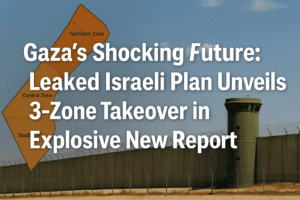Gaza’s Shocking Future: Leaked Israeli Plan Unveils 3-Zone Takeover in Explosive New Report
A leaked Israeli military blueprint, reported by The Times, outlines plans to divide Gaza into three civilian zones encircled by Israeli-controlled military corridors, restricting movement without authorization. This strategy, emerging amid intensified airstrikes and a ground offensive (Operation Gideon’s Chariot), coincides with the 76th anniversary of the Nakba—a symbolic reminder of historical displacement for Palestinians.
Over 300 Gazans have been killed in 72 hours, with 3,000 dead since Israel resumed hostilities in March, exacerbating a humanitarian catastrophe marked by famine risks and collapsed healthcare. The U.S. reportedly explores relocating Gazans to Libya in exchange for unfreezing Libyan assets, echoing Trump’s earlier controversial proposals. Ceasefire talks in Qatar stall as Hamas demands a permanent truce and Israeli withdrawal, conditions Netanyahu rejects. Analysts warn fragmented control risks entrenching resistance, mirroring West Bank tensions. With roads and military infrastructure replacing razed neighborhoods, Gaza’s future hangs between geopolitical gambits and a deepening civilian nightmare.

Gaza’s Shocking Future: Leaked Israeli Plan Unveils 3-Zone Takeover in Explosive New Report
As ceasefire negotiations between Israel and Hamas resume in Qatar, a leaked military blueprint suggests a controversial long-term strategy for Gaza that risks deepening humanitarian crises and historical wounds. The reported plan, obtained by diplomats and shared with The Times, outlines Israel’s intent to carve Gaza into three civilian zones separated by military-controlled corridors—a move critics compare to the mass displacement of Palestinians during the 1948 Nakba.
The Leaked Blueprint: “Complete Takeover of Gaza”
According to the document, Gaza would be divided into three isolated civilian areas: northern, central, and southern. These zones would be encircled by four military-only corridors, restricting movement between regions without Israeli authorization. Roads and infrastructure for these corridors are reportedly already under construction, often built atop razed residential neighborhoods. Analysts warn this could sever communities from their homes, farmlands, and critical services, effectively trapping civilians in enclaves under military surveillance.
The Israeli government has neither confirmed nor denied the plan, but its timing aligns with Prime Minister Benjamin Netanyahu’s recent pledge to establish a “sustained presence” in Gaza. Defense Minister Israel Katz confirmed the launch of Operation Gideon’s Chariot—a ground offensive expanding Israel’s control over northern and central Gaza—hours after U.S. President Donald Trump concluded a Middle East tour.
Nakba Echoes: A Symbolic Anniversary Amid Crisis
The leak surfaced on May 15, the 76th anniversary of the Nakba (“catastrophe”), when 750,000 Palestinians were displaced during Israel’s founding. For many, the parallels are stark. “This is a second Nakba,” said Ramy Abdu, chair of the Euro-Med Human Rights Monitor. “Forced displacement, controlled zones—it’s systemic erasure of Palestinian autonomy.”
In London, tens of thousands marched to commemorate Nakba Day, while in Gaza, families fleeing airstrikes carried scant belongings through rubble-strewn streets. “Until when? Until we all die?” asked Naji Awaisa, displaced from Jabalia refugee camp after a strike killed four children.
Humanitarian Collapse and International Scrutiny
Gaza’s humanitarian crisis has reached catastrophic levels:
- Blockade: No food, water, or fuel has entered Gaza in three months. The UN warns of imminent famine.
- Casualties: Over 3,000 Palestinians have been killed since Israel resumed hostilities in March, including 300 in the past 72 hours.
- Infrastructure: Hospitals, already crippled by shortages, report treating hundreds daily for injuries and malnutrition.
Meanwhile, the U.S. is allegedly exploring a contentious proposal to resettle up to a million Gazans in Libya in exchange for unfreezing $30 billion in Libyan assets, per NBC sources. The plan, reminiscent of Trump’s February suggestion to turn Gaza into a “Middle Eastern Riviera,” has drawn condemnation from Arab leaders and human rights groups.
Ceasefire Talks and Military Calculus
While Qatar-mediated negotiations continue, Israel’s military advances suggest low confidence in a deal. Hamas demands a permanent ceasefire and full Israeli withdrawal—conditions Netanyahu rejects, vowing to continue until Hamas is dismantled and hostages freed.
The offensive’s timing—following Trump’s visit—hints at geopolitical maneuvering. Trump’s muted criticism of Israel’s blockade (“a lot of people are starving”) contrasts with his administration’s alleged relocation plans, raising questions about U.S. involvement in reshaping Gaza’s demographics.
The Road Ahead: Fractured Sovereignty or Diplomatic Breakthrough?
The leaked plan underscores Israel’s vision for Gaza: a territorially fragmented, militarily dominated space. Yet its feasibility remains uncertain. Analysts note that similar strategies in the West Bank have fueled decades of conflict, not stability.
“Permanent military zones will only deepen resistance,” warns Tareq Baconi, author of Hamas Contained. “Without a political solution addressing Palestinian self-determination, cycles of violence will persist.”
As global pressure mounts, the coming days could determine whether Gaza faces further fragmentation or a fragile path toward ceasefire. For now, families in Rafah and Deir al-Balah bury their dead, their futures hanging on decisions made in distant capitals.
You must be logged in to post a comment.